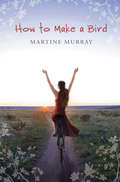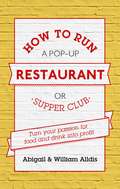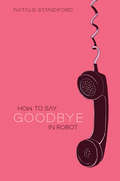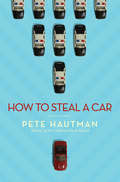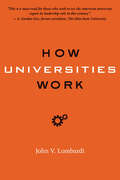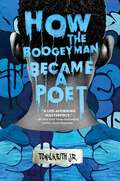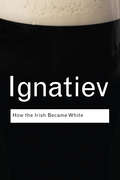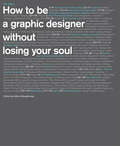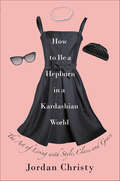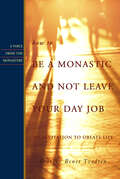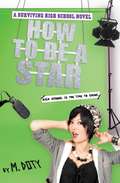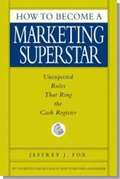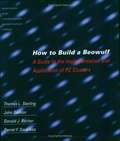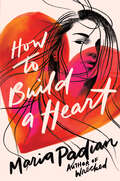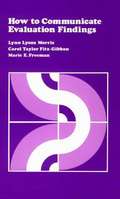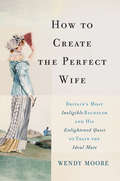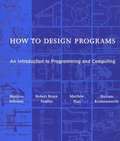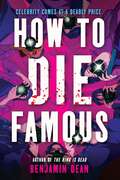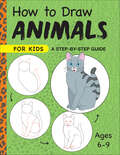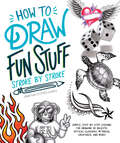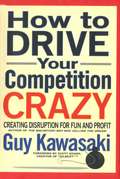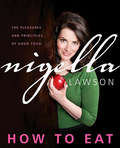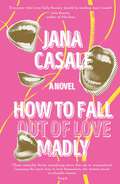- Table View
- List View
How To Make A Bird
by Martine MurrayA beautiful novel that captures the aching of a teenager ready to heal.It's dawn, on an empty road in the countryside. Empty, except for the girl in the long, red evening gown, standing next to a bicycle, and looking back at the home she's about to leave. Mannie's ready to start a new life and forget the terrible things that have happened here, but there are questions that need to be answered before she can let go. Questions about her elegant but unstable mother, her brother who's always overshadowed her, and his friend Harry Jacob, who just might be Mannie's boyfriend . . .
How To Run A Pop-Up Restaurant or Supper Club: Turn Your Passion For Food and Drink Into Profit
by Abigail Alldis William AlldisThis book is packed with everything amateur chefs need to know about delivering a pop-up restaurant. Including tips from the country's leading pop-up restaurateurs, the authors reveal everything from creating a menu, publicizing the event, dressing your venue, to running an organized kitchen. Discover how to: Theme your evening, and pick a fool-proof menu Organize front of house, and keep your customers happy Price your event and get free publicity Avoid licensing and health-and-safety pitfalls Guarantee your first pop-up is a roaring success Peppered with case studies from novices and professionals, you'll learn from other chefs' successes (and near-successes!) so your own evening runs without a hitch.
How To Run A Pop-Up Restaurant or Supper Club: Turn Your Passion For Food and Drink Into Profit
by Abigail Alldis William AldisThis book is packed with everything amateur chefs need to know about delivering a pop-up restaurant. Including tips from the country’s leading pop-up restaurateurs, the authors reveal everything from creating a menu, publicizing the event, dressing your venue, to running an organized kitchen. Discover how to:Theme your evening, and pick a fool-proof menuOrganize front of house, and keep your customers happyPrice your event and get free publicityAvoid licensing and health-and-safety pitfallsGuarantee your first pop-up is a roaring successPeppered with case studies from novices and professionals, you’ll learn from other chefs’ successes (and near-successes!) so your own evening runs without a hitch.
How To Say Goodbye In Robot
by Natalie StandifordFrom bestselling author Natalie Standiford, an amazing, touching story of two friends navigating the dark waters of their senior year.New to town, Beatrice is expecting her new best friend to be one of the girls she meets on the first day. But instead, the alphabet conspires to seat her next to Jonah, aka Ghost Boy, a quiet loner who hasn't made a new friend since third grade. Something about him, though, gets to Bea, and soon they form an unexpected friendship. It's not romance, exactly - but it's definitely love. Still, Bea can't quite dispel Jonah's gloom and doom - and as she finds out his family history, she understands why. Can Bea help Jonah? Or is he destined to vanish?
How To Steal a Car
by Pete HautmanFrom National Book Award winner Pete Hautman, the story of a girl who acts out by stealing cars.Some girls act out by drinking or doing drugs. Some girls act out by sleeping with guys. Some girls act out by starving themselves or cutting themselves. Some girls act out by being a bitch to other girls. Not Kelleigh. Kelleigh steals cars.In How to Steal a Car, National Book Award winner Pete Hautman takes teen readers on a thrilling, scary ride through one suburban girl's turbulent life - one car theft at a time.
How Universities Work (Higher Ed Leadership Essentials)
by John V. LombardiThe single best description of the inside workings of contemporary universities.Witty and insightful, How Universities Work is destined to be an essential handbook for anyone wanting to understand universities in the United States. John V. Lombardi gives readers an insider’s view of the academy, describing the structure, logic, dynamics, and operational styles of both public and private institutions of higher education. Lombardi defines and describes all the bits and pieces that compose a university with remarkable economy—from budgeting systems to tenure, from the library to the athletic field. Although focused on research universities, much of the discussion applies to other types of post-secondary institutions. Ideal for students, this book will form a solid foundation for courses in higher education, but it will also be a welcome addition to faculty and administrators’ personal libraries.
How the Boogeyman Became a Poet
by Tony Keith, Jr.Poet, writer, and hip-hop educator Tony Keith Jr. makes his debut with a powerful YA memoir in verse, tracing his journey from being a closeted gay Black teen battling poverty, racism, and homophobia to becoming an openly gay first-generation college student who finds freedom in poetry. Perfect for fans of Elizabeth Acevedo, George M. Johnson, and Jacqueline Woodson.Tony dreams about life after high school, where his poetic voice can find freedom on the stage and page. But the Boogeyman has been following Tony since he was six years old. First, the Boogeyman was after his Blackness, but Tony has learned It knows more than that: Tony wants to be the first in his family to attend college, but there’s no path to follow. He also has feelings for boys, desires that don’t align with the script he thinks is set for him and his girlfriend, Blu.Despite a supportive network of family and friends, Tony doesn’t breathe a word to anyone about his feelings. As he grapples with his sexuality and moves from high school to college, he struggles with loneliness while finding solace in gay chat rooms and writing poetry. But how do you find your poetic voice when you are hiding the most important parts of yourself? And how do you escape the Boogeyman when it's lurking inside you?
How the Irish Became White (Routledge Classics)
by Noel Ignatiev'…from time to time a study comes along that truly can be called ‘path breaking,’ ‘seminal,’ ‘essential,’ a ‘must read.’ How the Irish Became White is such a study.' John Bracey, W.E.B. Du Bois Department of Afro-American Studies, University of Massachussetts, Amherst The Irish came to America in the eighteenth century, fleeing a homeland under foreign occupation and a caste system that regarded them as the lowest form of humanity. In the new country – a land of opportunity – they found a very different form of social hierarchy, one that was based on the color of a person’s skin. Noel Ignatiev’s 1995 book – the first published work of one of America’s leading and most controversial historians – tells the story of how the oppressed became the oppressors; how the new Irish immigrants achieved acceptance among an initially hostile population only by proving that they could be more brutal in their oppression of African Americans than the nativists. This is the story of How the Irish Became White.
How to Be a Graphic Designer without Losing Your Soul: Without Losing Your Soul
by Adrian ShaughnessyPublished to instant acclaim in 2005, our best selling How to Be a Graphic Designer without Losing Your Soul has become a trusted resource for graphic designers around the world, combining practical advice with philosophical guidance to help young professionals embark on their careers. This new, expanded edition brings this essential text up to date with new chapters on professional skills, the creative process, and global trends that include social responsibility, ethics, and the rise of digital culture. How to Be a Graphic Designer offers clear, concise guidance along with focused, no-nonsense strategies for setting up, running, and promoting a studio; finding work; and collaborating with clients. The book also includes inspiring new interviews with leading designers, including Jonathan Barnbrook, Sara De Bondt, Stephen Doyle, Ben Drury, Paul Sahre, Dmitri Siegel, Sophie Thomas, and Magnus Vol Mathiassen
How to Be a Hepburn in a Kardashian World: The Art of Living with Style, Class, and Grace
by Jordan ChristyJordan Christy shares advice on how to be the most confident version of yourself, in this fully revised and updated edition derived from How to Be a Hepburn in a Hilton World.Though fashions may change, certain things never go out of style -- like your favorite little black dress that can take you from a business meeting to a dinner party to a night on the town. But what makes it work is not the dress, it's how you present yourself while wearing it. A woman who is polite, well spoken, gracious, charming, and thoughtful is always welcome-though such women appear to be in short supply these days! Despite the headline-grabbing antics of certain flashy celebutantes, most of us would rather have respect -- for ourselves and from our family, friends, and colleagues.In this fully revised and updated edition, you will learn how to: Appear polished without sacrificing your personal style, Develop skills and discover interests to boost your self-confidence,Find your true friendships and make them stronger,Date Mr. Right instead of hooking up with Mr. Right Now,Land the perfect internship and your first job,Have a fun night without the risk of a social media faux pas.With this insightful guide you'll be loving life with style, class, and grace in no time!
How to Be a Monastic and Not Leave Your Day Job: A Guide for Benedictine Oblates and Other Christians Who Follow the Monastic Way (Voices from the Monastery)
by Benet TvedtenDiscussion around the bestseller The Benedict Option by Rod Dreher has led many people to want to know more about Benedictine principles. Originally written for monks, the principles in the Rule of St. Benedict may be applied by anyone — and in today's hectic, changing world, following its principles offers a rich spiritual connection to the stability and wisdom of monastic life. This essential guide explains how people who live and work in "the world" are still invited to balance work with prayer, cultivate interdependence with others, practice hospitality, and otherwise practice their spirituality like monks.
How to Be a Star (Surviving High School #2)
by M. DotyHigh school is the time to shine.Tired of playing sidekick to her superstar-athlete best friend, Kimi Chen has decided it's time to step into the spotlight and snag her own place at the coveted center table of the cafeteria. When her low-budget music video hits the Web and goes viral, forget about being just popular -- Kimi is famous! Boys want to date her, girls want to be her, and she is even asked to perform on her favorite TV show. After years of feeling stranded on the bottom rung of the social ladder, Kimi finds that things are finally looking up.But when fame gets in the way of her friendships, Kimi's celebrity begins to lose some of its sparkle. Being a star, it turns out, may be more than she bargained for.Discover the high price of fame and stardom in this second novel in the Surviving High School series, based on the hit mobile game from Electronic Arts.
How to Become a Marketing Superstar: Unexpected Rules that Ring the Cash Register
by Jeffrey J. FoxWith more than 600,000 books in print, nationally bestselling author Jeffrey Fox is back to 'outfox the competition'--this time with counterintuitive advice on how to become a marketing genius n his four previous bestselling business books, Jeffrey Fox has helped readers land great jobs and rise to the top of their professions. Now he turns his contrarian eye to marketing through brand building and innovation. Fox's advice is delivered in snappy, to-the-point chapters that zero in on his creative--and often counterintuitive--advice and features such unforgettable fundamentals as: Make a big splash, instead of a lot of little ripples Always have a pipeline to the president Own a market, not a mill The long and short definitions of marketingThere are also provocative 'Instant Marketing Superstar' challenges throughout the book, offering the reader a chance to solve real business problems. In a time of corporate budget cuts, it's more important than ever for all employees to be creative marketers. How to Become a Marketing Superstar is certain to find a place on the shelves of anyone who wants to increase sales in a competitive marketplace.
How to Build a Beowulf: A Guide to the Implementation and Application of PC Clusters
by Thomas L. Sterling John Salmon Donald J. Becker Daniel F. SavareseSupercomputing research--the goal of which is to make computers that are ever faster and more powerful--has been at the cutting edge of computer technology since the early 1960s. Until recently, research cost in the millions of dollars, and many of the companies that originally made supercomputers are now out of business. The early supercomputers used distributed computing and parallel processing to link processors together in a single machine, often called a mainframe. Exploiting the same technology, researchers are now using off-the-shelf PCs to produce computers with supercomputer performance. It is now possible to make a supercomputer for less than $40,000. Given this new affordability, a number of universities and research laboratories are experimenting with installing such Beowulf-type systems in their facilities. This how-to guide provides step-by-step instructions for building a Beowulf-type computer, including the physical elements that make up a clustered PC computing system, the software required (most of which is freely available), and insights on how to organize the code to exploit parallelism. The book also includes a list of potential pitfalls.
How to Build a Heart
by Maria PadianOne young woman’s journey to find her place in the world as the carefully separated strands of her life — family, money, school, and love — begin to overlap and tangle. <P><P>All sixteen-year-old Izzy Crawford wants is to feel like she really belongs somewhere. Her father, a marine, died in Iraq six years ago, and Izzy’s moved to a new town nearly every year since, far from the help of her extended family in North Carolina and Puerto Rico. When Izzy’s hardworking mom moves their small family to Virginia, all her dreams start clicking into place. She likes her new school—even if Izzy is careful to keep her scholarship-student status hidden from her well-to-do classmates and her new athletic and popular boyfriend. And best of all: Izzy’s family has been selected by Habitat for Humanity to build and move into a brand-new house. <P><P>Izzy is this close to the community and permanence she’s been searching for, until all the secret pieces of her life begin to collide. <P><P>How to Build a Heart is the story of Izzy’s journey to find her place in the world and her discovery that the choices we make and the people we love ultimately define us and bring us home.
How to Communicate Evaluation Findings
by Lynn Lyons Morris Carol Taylor Fitz-Gibbon Marie E. FreemanThe purpose of this book is to help you communicate the evaluation information you have collected. The book contains prescriptions and advice to help an evaluator provide information that will be usable and used at many stages of a program's development.
How to Cook Like a Top Chef
by Bravo MediaRecipes, techniques, photos, and interviews from Bravo’s hit show!The best food show on cable TV presents the ultimate guide to becoming a Top Chef. This combination cookbook and culinary primer features recipes from the show (and from season one of Top Chef: Masters), along with insider techniques from favorite contestants and judges.Covering everything from knife skills to sauces and sous-vide, How to Cook Like a Top Chef teaches aspiring chefs what it takes to be a star in the kitchen. Packed with exclusive content, including a foreword by Top Chef: Masters winner Rick Bayless, original recipes from contestants, behind-the-scenes interviews, juicy trivia, and tons of tips and tricks, this volume is indispensable on the cook’s countertop and essential reading for Top Chef fans.
How to Create the Perfect Wife: Britain's Most Ineligible Bachelor and his Enlightened Quest to Train the Ideal Mate
by Wendy MooreThomas Day, an 18th-century British writer and radical, knew exactly the sort of woman he wanted to marry. Pure and virginal like an English country maid yet tough and hardy like a Spartan heroine, she would live with him in an isolated cottage, completely subservient to his whims. But after being rejected by a number of spirited young women, Day concluded that the perfect partner he envisioned simply did not exist in frivolous, fashion-obsessed Georgian society. Rather than conceding defeat and giving up his search for the woman of his dreams, however, Day set out to create her. So begins the extraordinary true story at the heart of How to Create the Perfect Wife, prize-winning historian Wendy Moore's captivating tale of one man's mission to groom his ideal mate. A few days after he turned twenty-one and inherited a large fortune, Day adopted two young orphans from the Foundling Hospital and, guided by the writings of Jean-Jacques Rousseau and the principles of the Enlightenment, attempted to teach them to be model wives. After six months he discarded one girl, calling her "invincibly stupid," and focused his efforts on his remaining charge. He subjected her to a number of cruel trials--including dropping hot wax on her arms and firing pistols at her skirts--to test her resolve but the young woman, perhaps unsurprisingly, eventually rebelled against her domestic slavery. Day had hoped eventually to marry her, but his peculiar experiment inevitably backfired--though not before he had taken his theories about marriage, education, and femininity to shocking extremes. Stranger than fiction, blending tragedy and farce, How to Create the Perfect Wife is an engrossing tale of the radicalism--and deep contradictions--at the heart of the Enlightenment.
How to Design Programs: An Introduction to Programming and Computing
by Matthias Felleisen Robert Bruce Findler Shriram Krishnamurthi Matthew FlattThis introduction to programming places computer science in the core of a liberal arts education. Unlike other introductory books, it focuses on the program design process. This approach fosters a variety of skills--critical reading, analytical thinking, creative synthesis, and attention to detail--that are important for everyone, not just future computer programmers. The book exposes readers to two fundamentally new ideas. First, it presents program design guidelines that show the reader how to analyze a problem statement; how to formulate concise goals; how to make up examples; how to develop an outline of the solution, based on the analysis; how to finish the program; and how to test. Each step produces a well-defined intermediate product. Second, the book comes with a novel programming environment, the first one explicitly designed for beginners. The environment grows with the readers as they master the material in the book until it supports a full-fledged language for the whole spectrum of programming tasks. All the book's support materials are available for free on the Web. The Web site includes the environment, teacher guides, exercises for all levels, solutions, and additional projects.
How to Die Famous
by Benjamin DeanFor fans of Little White Lies and Two Can Keep a Secret comes an addictive thriller about a budding teen celebrity secretly investigating his brother's suspicious death while navigating the highs and lows of fame. Rising star Abel Miller has just landed a role in one of the hottest reboots on the Omni Channel, Sunset High. It looks like he&’ll be yet another budding celebrity plucked from obscurity, but he has a secret: his brother, Adam, a mere production associate, died during the filming of the last attempt at Sunset High, and no one knows how... or why. Abel is going to find out. But when he meets the other stars of the show— Lucky, Ryan, and Ella, along with creator Lake Carter— he realizes there&’s even more darkness beneath the shimmer of fame. They all have their own secrets to hide, and one of them is willing to kill to keep it that way.
How to Draw Animals for Kids: A Step by Step Guide (Drawing for Kids Ages 6 to 9)
by Rockridge PressLearn to draw animals with step-by-step activities for kids ages 6 to 9Anyone can be an artist—all you need is your imagination! Learn how to draw beginner-friendly adorable animals with this step-by-step drawing book for kids. It's full of activities, helpful tips, and lots of animals to draw—from cats and dogs to owls and elephants. A great resource for parents and teachers to teach kids to draw shapes, lines, and other drawing basics. Build on these skills, advance to more challenging animals, and then customize them into something unique. Just grab a pencil and get ready to explore the animal kingdom!A world of animals—Draw animals from the land, sea, and sky, including dolphins, bald eagles, sloths, pandas, goldfish, penguins, and more.Step-by-step method—Follow along and develop your drawing from basic shapes like circles and lines all the way to a beautifully detailed animal.Time to get creative—Get your imagination going with blank scenes that let you draw in your own animals, along with extra drawing ideas so you can keep creating.Discover how to draw animals the easy way with the step-by-step instructions in this book about drawing for kids.
How to Draw Fun Stuff Stroke-by-Stroke: Simple, Step-by-Step Lessons for Drawing 3D Objects, Optical Illusions, Mythical
by Jonathan Stephen HarrisA fresh and exciting drawing guide for young artists who seek projects that are out of the ordinary.Are you tired of drawing the same boring stuff? Artist and author Jonathan Stephen Harris shows you how to draw almost anything with 40 fun and exciting projects that are anything but boring. You'll learn how to create crazy trick art, amazing 3D objects, mind-blowing anamorphic illustrations, and brain-twisting optical illusions. Every project features detailed, step-by-step instructions and illustrations that use color to help teach you exactly how to do it. You'll start by learning the basics of drawing, what tools you need, and the basic techniques you need to know so you can create your own amazing drawings. Soon you'll be creating works of amazing art that is out of this world! Here's what's inside:40 exciting drawing projects that will thrill young artists of all levels of ability.Detailed, step-by-step instructions that take readers through every drawing from start to finish, using color to illustrate new lines so the reader can clearly see the next steps.Simple tutorials for basic drawing skills like shading as well as creating textures and surfaces so readers can learn drawing the right way.Tons of creative ideas that will inspire you to create your own amazing works of art.
How to Drive Your Competition Crazy: Creating Disruption for Fun and Profit
by Guy KawasakiA rogue business strategist and marketing expert offers irreverent, unconventional, and extreme strategies in sales, marketing, production, and human resources to crush the competition. If you were intrigued by the title of this book, you are probably the type of business book reader who's had enough of management self-help and touchy-feely tomes, enough of how-to guides that encourage you to take the kinder, gentler approach to competitors, customers, and employees. You are ready for the gloves to come off, and the one thing you'll want in your hands when they do is the first can-do, how-to, kick-butt gonzo guide to driving your competitors off the deep end. In the time-honored tradition of the maxim "It's not how you play the game, but whether you win or lose," Forbes columnist and bestselling author of Selling the Dream Guy Kawasaki has written the definitive take-no-prisoners guide to help the Davids beat the Goliaths. The product of Kawasaki's years of experience as an evangelist for the then-upstart Apple and as a computer guru and business strategist, How to Drive Your Competition Crazy is an invaluable source book of irreverent and sometimes extreme stratagems in sales, marketing, production, and human resources that will help your company or organization get and keep the upper hand. Whether you are launching a new company or product, consolidating your strength in the marketplace, or trying to hold your own against a competitor with greater resources, How to Drive Your Competition Crazy offers a comprehensive blueprint for success. From the initial steps of learning as much about your own company as you do about your enemy to advanced techniques like playing with your opponents' minds, Guy Kawasaki explores every facet of the premise that the best defense is a good offense. Staking territory somewhere between the arts of Zen and war, How to Drive Your Competition Crazy is a resource no company can afford to be without.
How to Eat
by Nigella LawsonThrough her wildly popular television shows, her five bestselling cookbooks, her line of kitchenware, and her frequent media appearances, Nigella Lawson has emerged as one of the food world's most seductive personalities. How to Eat is the book that started it all--Nigella's signature, all-purposed cookbook, brimming with easygoing mealtime strategies and 350 mouthwatering recipes, from a truly sublime Tarragon French Roast Chicken to a totally decadent Chocolate Raspberry Pudding Cake. Here is Nigella's total (and totally irresistible) approach to food--the book that lays bare her secrets for finding pleasure in the simple things that we cook and eat every day.
How to Fall Out of Love Madly
by Jana Casale&“Three relatable thirty somethings drive this ode to womanhood. Learning the hard way to love themselves, the women teach invaluable lessons.&”—People &“Everyone who loves Sally Rooney should be reading Jana Casale!&”—Julie Buntin, author of Marlena Three women confront the compromises they&’ve made to appease the men they love. Joy and Annie are friends and roommates whose thirty-something lives aren&’t exactly what they&’d imagined. To make ends meet, they decide to rent their extra bedroom to Theo, who charms Joy with his salt-and-pepper hair and adoration of their one-eyed cat. When Annie goes to live with her boyfriend, Theo and Joy settle into a comfortable domesticity. Then Theo brings home Celine, the girlfriend he&’s never mentioned, who is possibly the most stunning woman Joy has ever seen. Joy resolves to do whatever it takes to hold on to him, falling ever deeper into an emotional hellscape of her own making. She is too obsessed to realize that Celine&’s beauty doesn&’t protect her from pain. Haunted by an event from her past, Celine can&’t escape her shame and finds herself in an endless cycle of self-sabotage. Annie is baffled by Joy&’s senseless devotion to Theo, but she&’s consumed by her own obsessions: she can&’t stop parsing her commitment-phobic boyfriend&’s texts in an exhausting mission to maintain his approval. At work, where she fully embraces her natural assertiveness, Annie is a star. But when an anonymous letter lands on her desk accusing her esteemed and supportive boss of sexual misconduct, she is forced to decide who and what she&’s willing to stand up for. Perceptive, mordantly funny, and full of heart, How to Fall Out of Love Madly examines women&’s many relationships—with one another, their mothers, their work, men, and themselves—to reveal their underlying power and complexity. It asks, why do so many smart, compassionate, otherwise empowered women tolerate egregious behavior from the men they love? And what will it take for them to reclaim control?
